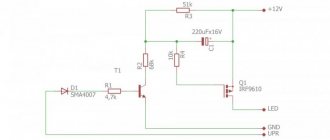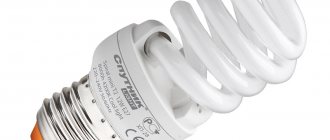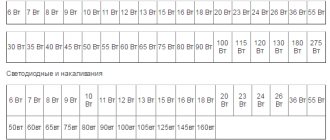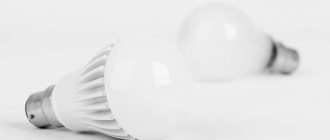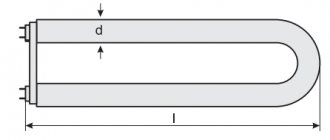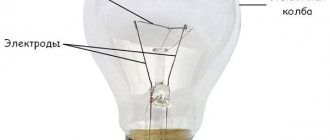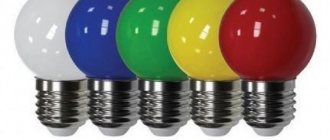Throughout history, many discoveries that, at first glance, seem trivial, have turned our world upside down and made our lives easier. This applies to such simple things as a wheel, reinforced concrete, plastic, superglue and much more. Such inventions include the light bulb.
It would seem that a small and rather primitive device has become an important element of our life. They illuminate our houses, the road while driving, the streets at night and everything else. Every year they are improved and they try to make them as economical as possible, thanks to which they reduce energy consumption and, accordingly, costs. Today we would like to talk specifically about the efficiency of various types of light bulbs. First of all, let's note what they are. Most often in everyday life we use the following types:
- incandescent lamps;
- LED;
- fluorescent or energy-saving.
How much energy do incandescent light bulbs of different wattages consume per hour and month?
To carry out calculations, it is necessary to take the most popular models of light sources. If we consider classic incandescent lamps, then most often their power ranges from 40 to 75 W. Quite rarely, more powerful products of 100 or even 200 W are used.
In some cases, private clients purchase them to illuminate the street at night. Now let’s carry out a simple calculation of their energy consumption. On average, one apartment or house uses 4 light bulbs with a power of 60 watts. They are turned on for several hours a day. Let's take the average value - 4 hours (in summer they are rarely used, but in winter they burn for a very long time, since daylight hours are much shorter).
Now let's calculate how much energy they spend per day: 4*4*60=960 W. Per month, this figure will be equal to 28800 W, or 28.8 kW. The cost of one kilowatt is 5.5 rubles (in Moscow). It turns out that 4 such light bulbs per month on average “take” 158.4 rubles from our wallet.
If we take another power, for example, 40 W, then the total amount of electricity consumed will be 640 W per day and 19200 W per month. In monetary terms, this figure will be 105.6 rubles. For light bulbs with a power of 75 W, the final figures will be as follows: 1200 W, 36000 W, 198 rubles. In general, the amount is not very large, considering that this expense item is only a small part of the total amount for utilities.
For this reason, you have to think about saving money. First, when there are no people in the room, you need to turn off the lights. Secondly, it is recommended to switch to lower wattage light bulbs. Thirdly, you can reduce their number.
With the first point, everything is logical: I left the room and turned off the light. With the second, not everything is so simple, since low illumination causes a certain discomfort - from an insufficient amount of light, the eyes begin to quickly get tired or we simply begin to see poorly. But the second point from this list can be solved very easily - replace classic and already obsolete incandescent lamps with energy-saving ones.
Consumption calculations
To calculate how much electricity any light source consumes, several steps are required:
- look at the power indicated as W on the product or packaging;
- divide the number by 1000 (to get the value in kilowatts);
- determine how many hours a day the family uses the lamp;
- multiply the number by 30.
Next, the power (item 2) is multiplied by hours (item 4).
To find out how much one lamp consumes in rubles, the final calculation result is multiplied by the tariff.
LED light bulbs
For example, you can take a two-room apartment, in which there are 3 lamps of 100 W each (in living quarters and in the kitchen) and 3 lamps of 60 W each (in the bathroom, toilet and hallway).
If they are on:
- in the living room 4 hours in the evening and 1 in the morning;
- in the bedroom 2 hours in the evening and 2 in the morning;
- in the kitchen 3 hours in the evening and 1 in the morning;
- in the hallway and toilet for an hour a day;
- in the bathroom 2 hours in the evening and 1 in the morning.
When replacing with LED sources, 3 products of 14 W and 3 of 10 W are used.
Per day, such a system consumes:
12*14+4*10=208 W=0.208 kW
With an average tariff of 4 rubles. for 1 kW per month we will pay 24.96 rubles.
Energy saving light bulbs
If filament sources are replaced with energy-saving ones, then you need to buy 3 products for 20 W and 3 for 12 W.
All devices consume per day:
12*26+4*15=372W=0.372 kW
You need to pay 44.64 rubles per month.
Incandescent light bulbs
An incandescent lamp converts only 10-20% of electricity into light, the rest is spent on heat.
For the same apartment, when using sources with incandescent filament, they consume per day:
12*100+4*60=640 W=0.64 kW
You need to pay 76.80 rubles per month.
Energy consumption of a fluorescent light bulb
I would immediately like to note that with the same luminous flux, energy-saving light bulbs (ESL) consume 5 times less energy than an incandescent lamp. It turns out that instead of 60 W, ESL consumes 12 W, instead of 100 W - only 20. If, for example, we take the same 4 light bulbs of 12 W, then they consume only 192 W per day, and 5760 per month. In financial terms, this will cost only at 32 rubles per month instead of 158, i.e. savings - 126 rubles per month.
However, do not forget that their cost is much higher. Thus, the price of incandescent lamps is about 20–50 rubles per piece. ESL, in turn, will cost you 100–300 rubles. That is, the cost of one joke is 100–250 rubles more. If you need 4 of them, then you will have to spend 1 thousand rubles at a time (when choosing the most expensive product). more. As can be seen from the calculations, savings occur in the 9th month of use. However, do not forget that the service life of ESLs is several times higher than that of classic incandescent light bulbs. While one ESL is working and pleases us with its savings, you will have time to change 2-3 incandescent lamps.
1.5 Replacing incandescent lamps for local lighting of machines
The efficiency of the system—the light source together with the ballast—is understood as the luminous flux (in lumens) that is generated when 1 W of electrical power is supplied to the lighting device.
Have you ever wondered how much a particular light bulb costs you? Is it really profitable to change it to fluorescent or LED?
No, there’s definitely nothing wrong with the data, it’s just that the numbers are average, especially since it also contains an explanation of what determines higher or lower energy consumption.
Divide this number by 180 hours and get 5.5 months. This is how long an incandescent lamp will work on average.
At first glance, the energy savings calculation did not show significant savings. Now let's see what the savings will be per year.
All-knowing statistics claim that 14% of all generated electricity is spent on lighting in Russia. But do we always use this incredible amount of extra energy wisely and without harm to ourselves? How to learn to do it correctly?
The subjective perception of illumination is influenced not only by the luminous flux emitted by the lamp. The shade of light is no less important.
The service life is adversely affected by a large number of starts and poor quality of electricity. All these factors lead to the fact that the service life is less than declared.
How much does an LED light bulb consume?
If we talk about LED bulbs, then they are the most profitable. The fact is that they consume 7 times less energy than an incandescent lamp. To confirm this, let's give specific numbers. It turns out that they consume 4*8.5 per day (equivalent to 60-watt incandescent lamps)*4=136 W. The monthly consumption will be 4 kW, which in monetary terms will be a ridiculous 22 rubles. The cost of such a light source also varies in the range from 100 to 300 rubles. It turns out that you will have to overpay the same thousand rubles for 4 light bulbs.
How then can you calculate the payback time of energy-saving lamps?
LEDs are safe, do not require special disposal, and consume from 3 to 7 W. They cost more from 160 to 350 rubles.
Threaded or Edison base. Their marking consists of the letter “E” and a number indicating the diameter. The most common are E14 (minion E14), E27 (most often used) and E40 (changes in high-power devices corresponding to old incandescent lamps 0.5–1 kW). For example, if you are used to using a 100-watt incandescent lamp, then a 20-watt energy-saving lamp will provide you with the same lighting. When purchasing an energy-saving lamp, pay attention to the dimensions; the lamp must fit freely in a lamp or chandelier.
Color rendering index (Ra or CRI) is an indicator that determines the naturalness of color under artificial lighting.
Unless the last digit on the right is separated from the others by a comma or has a different color, it shows whole kilowatt-hours.
Try not to overload the washing machine (overloading increases electricity consumption by up to 10%) and use a medium temperature setting.
Fluorescent energy-saving lamps, which operate on a different principle and their structure is fundamentally different from the “Ilyich light bulb,” should help reduce electricity costs.
Try not to overload the washing machine (overloading increases electricity consumption by up to 10%) and use a medium temperature setting.
Fluorescent energy-saving lamps, which operate on a different principle and their structure is fundamentally different from the “Ilyich light bulb,” should help reduce electricity costs.
Is it really profitable to change it to fluorescent or LED? To understand this, you just need to find out the power of the light bulb and the cost of electricity in your home.
Which light bulbs are more profitable to use?
As we can see, the most economical light bulbs are LED and fluorescent. True, the former were slightly ahead of the latter in this absentee “arms race.” In just a month of using 4 lamps, you save more than 100 rubles (with an average consumption of 4 hours a day). Their cost is approximately the same, as is their service life. However, for many consumers, the price factor is the main one, which is why they are not so willing to purchase them.
Many people simply feel sorry for paying up to 300 rubles for one light bulb. At the same time, they forget that the seller gives them an additional guarantee of up to two years. That is, if it “burns out” ahead of time, you can replace the failed element with a new one with a receipt and packaging. But many of our citizens do not want to carry out banal calculations; some simply see the price in the store and make a choice in favor of “outdated” budget products.
We recommend following the life principles of Baron Rothschild, who once said: “I’m not rich enough to buy cheap things.” After all, even in such a simple example as lamps, we see that it is better to pay more once than to overpay for the rest of your life.
Subscribe to our Social networks
conclusions
The payment amounts for 3 light bulbs working 4 hours a day and 30 days are highlighted in red:
- LED (the cost of the paw is from 200 to 800 rubles): 3.6 kW = 12.6 rubles.
- Energy saving (cost from 100 to 400 rubles): 12.96 kW = 46.36 rubles.
- Incandescent (cost from 10 to 100 rubles): 34.2 kW = 119.7 rubles.
It follows from this that the most profitable light bulbs in terms of energy costs are LED ones.
Source
How much electricity do household appliances consume?
Most likely, you have asked this question more than once. After all, every home has all kinds of equipment that consumes electricity.
POWER CONSUMPTION is one of the main characteristics of electrical appliances. Therefore, on any electrical device or in its instructions, precise information is indicated on the number of watts required for its operation. Of course, the amount of electricity consumed may vary and depends on the model of household appliances and the work they perform at a certain moment.
Below are the average indicators of the main most common electrical appliances and their approximate power:
1. Electric oven – 2300 watts 2. Dishwasher – 1500 watts 3. Hair dryer – 1538 watts 4. Heater – 1500 watts 5. Coffee maker – 1500 watts 6. Microwave oven – 1000 watts 7. Toaster oven (toaster oven) – 1200 watt. 8. Iron – 1100 watts 9. Toaster – 1100 watts 10. Room air conditioner – 1000 watts 11. Electric cooker – 1000 watts 12. Vacuum cleaner – 650 watts 13. Water heater – 479 watts 14. Washing machine – 425 watts 15. Coffee maker ka espresso (espresso machine) – 360 watts 16. Dehumidifier – 350 watts 17. Plasma TV – 339 watts 18. Blender – 300 watts 19. Freezer – 273 watts 20. Liquid crystal TV (LCD) – 213 watts 21. Refrigerator – 188 watts 22. Regular TV (with cathode ray tube) - 150 watts 23. Monitor - 150 watts 24. Computer (power supply) - 120 watts 25. Portable fan - 100 W 26. Stand mixer - 100 W 27. Electric opener for cans – 100 W 28. Curling iron – 90 W 29. Ceiling fan – 75 W 36. Humidifier – 75 W 30. Incandescent lamp (60 W) – 60 W 31. Stereo system – 60 W 32. Laptop – 50 W 33. Printer – 45 W 34. Digital Video Recorder (DVR) – 33 W 35. Aquarium – 30 W 36. Cable box – 20 W 37. Compact fluorescent lamp (energy saving lamp) equivalent to 60 W – 18 W 38. DVD player – 17 W 39. Satellite dish – 15 W 40. VCR – 11 W 41. Clock radio – 10 W 42. Portable stereo system (boombox) – 7 W 43. Wireless Wi-Fi router – 7 W 44. Charging for mobile phone – 4 W 45. Cordless phone – 3 W 46. Answering machine – 1 W
Given these data, 1000 WATT-HOURS (or 1 kilowatt-hour) is ENOUGH TO: 1. Receive 60,000 voicemail messages 2. Open 7,200 cans with an electric can opener 3. Listen to 2,143 songs on a portable stereo recorder 4. Print 1,333 pages on a printer 5. Prepare 400 cocktails in a blender 6. Knead 300 portions of dough with a mixer 7. Charge a mobile phone 278 times 8. Listen to 250 songs through the stereo system 9. Create 67 hairstyles using a hair curler 10. Prepare 36 toasts in a toaster 11. Talk 15 days on the phone 12. Use a wireless Wi-Fi router 6 days 13. Use a clock radio 4 days 14. Record 45 movies on a VCR 15. Use a satellite dish 67 hours 16. Watch 29 movies on a DVD player 17. Use an energy-saving light bulb 56 hours 18. Use a cable box 50 hours 19. Use an aquarium 33 hours 20. Use a digital video recorder (DVR) 30 hours 21. Use a laptop 20 hours 22. Use a 60-watt incandescent light bulb 17 hours 23. Use a humidifier 13 hours 24. Use a ceiling fan for 13 hours 25. Use a portable fan for 10 hours 26. Use a computer (system unit) for 8 hours 27. Use a monitor for 7 hours 28. Watch 13 episodes of a sitcom on a CRT TV 29. Watch 9 episodes of a sitcom on an LCD TV ) 30. Use the refrigerator for 5 hours 31. Use a dehumidifier for 3 hours 32. Watch 6 episodes of a sitcom on a plasma TV 33. Use the freezer for 4 hours 34. Heat 15 dishes in the microwave 35. Prepare espresso using an espresso machine 11 times 36. Iron iron 5 shirts 37. Make 4 hairstyles using a hair dryer 38. Wash clothes in the washing machine 3 times 39. Brew coffee in a coffee maker 3 times 40. Use the water heater for 2 hours 41. Cook 2 dishes on the electric stove 42. Vacuum for an hour and a half 43. Use room air conditioner 1 hour 44. Use the heater for 40 minutes 45. Bake cupcakes in the oven once 46. Use the dishwasher for 33 minutes (enough for 0.3 machine cycles)
It is worth noting that watt (kilowatt) and watt-hour (kilowatt-hour) are two different units of measurement and they refer to different physical quantities. Due to similar names, these concepts are often confused in everyday use, especially when it comes to electrical appliances. Power is measured in watts (W) and kilowatts (kW), that is, the amount of energy consumed by a device per unit of time. And watt-hour (Wh) or kilowatt-hour (kWh) are units of measurement of energy produced or work done by an electrical appliance and are mainly used to measure electricity consumption in the home or economy.
These two quantities are related as follows. If a 1,000-watt air conditioner ran for 1 hour, it would require 1,000 watt-hours (or 1 kilowatt-hour) to operate. A 1-watt answering machine will consume the same amount of power in 1000 hours.
Source: www.joinus.pro
